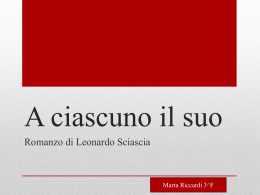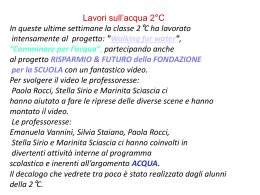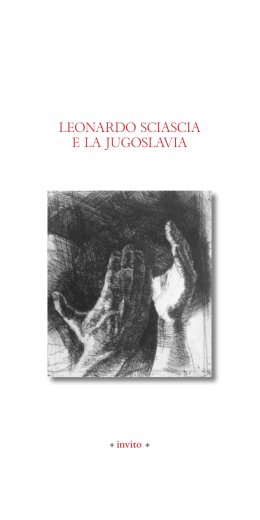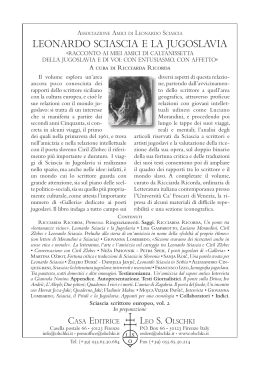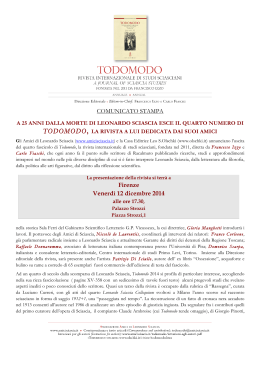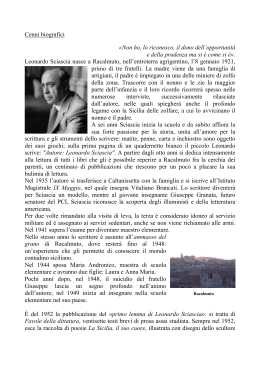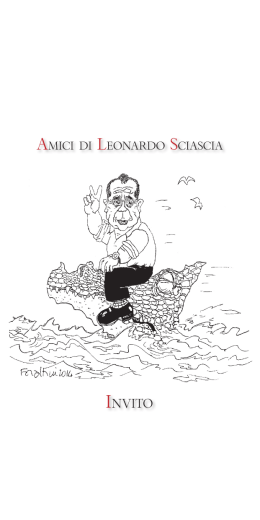XVI AAIS Conference April 11-14 1996 Leonardo Sciascia: una storia veramente semplice? Una storia semplice 1 was Sciascia’s last work, appearing in the bookshops on the day of his death, 20 November 1989. It is stylistically unlike his earlier excursions into the detective genre, which were imbued, for example, with many lyrical passages, and were replete with classical echoes and allusions. 2 Una storia semplice, described as “il piú sobrio e terso dei suoi racconti”, 3 has very little of this being far more direct in its style. What was Sciascia’s purpose in writing his ‘straightforward tale’? And how straightforward is it in reality? Il giorno della civetta (1961), the first of six ‘gialli’ covering the mafia, 4 received much acclaim (as Sciascia himself said, he was the first writer to deal with the subject in narrative form); 5 it reflects the transformation of the mafia in Sicily from rural to urban phenemenon; A ciascuno il suo (1966) reveals mafia ramifications at a national level, leading to Il contesto (1971), which emphasizes the universality of mafia. Todo modo (1974) deals with leading public figures, both political and religious, carrying out supposedly spiritual exercises at a remote hermitage-hotel. Then there is a fourteen-year gap in which Sciascia was occupied with writing at least twelve novels/historical enquiries. Why, then, did he return to deal with the theme of mafia in narrative form after so long? Perhaps he saw the ‘giallo’ as remaining his most effective form, as he still desired to communicate his ‘truths’ to as wide an audience as possible. He once said that he considered that one could find out more about historical truth from a novel than from a learned article. 6 In his final ‘giallino’, Sciascia portrays the transformation which the mafia, and organized crime, underwent in the late 1980s, as it concentrated even more on the accumulation of wealth, notably, as we see, through illegal art deals and the production of drugs in isolated villas. A year prior to the publication of Una storia semplice, came Il cavaliere e la morte, in which the setting is Northern, while Una storia semplice is enacted in Sicily, almost as if the Sicilianization of Italy referred to in Il giorno della civetta, and explored elsewhere, is now on a return path. Certainly, despite the universal stage for mafia operations, Sicily remained firmly the central power base. Or perhaps Sciascia returns to Sicily as the setting, since he was dying, as Tom O’Neill has suggested to me, and felt the centripetal pull of his roots, 7 or perhaps he, unlike Giorgio Roccella, the tale’s victim, was, as Joseph Farrell suggests, putting his own full stop to his life’s work. 8 So, in what ways can Una storia semplice be classed as ‘a simple tale’? The plot is certainly less intricate than those of Sciascia’s previous ‘gialli’, and brigadiere Lagandara, the protagonist, is a more straightforward character than either Inspector Rogas of Il contesto or the painter of Todo modo. He represents a typical southern Italian with his straightforward ambitions and aspirations. 9 The mafia, as it happens, is never explicitly mentioned, perhaps because, while Sciascia focuses on characteristics which are solidly Sicilian, and which still rouse him to anger, he intends to represent a more universal evil. As Giuseppe Bonura tells us: “Sciascia non era e non voleva essere un semplice narratore. [...] Indagava i mali e il dolore del mondo a cominciare dalla mafia, la quale per lui non era soltanto insulare ma nazionale, o per meglio dire planetaria.” 10 How does the story begin? It opens with the arrival of a phone call on the evening of the feast of St Joseph the Carpenter, a ‘simple’ profession. 11 Yet we immediately come across an example of simple words belying a hidden depth, and we note the irony so prevalent in Sciascia: the police offices are lit up, but only to give the impression of security and safety, a theme echoed in his earlier work. 12 Furthermore, as the brigadiere tells the caller, “il questore non è mai in questura a quest’ora”. 13 What are the reader’s expectations? The reader of detective novels naturally anticipates a puzzle and/or a death in suspicious circumstances, followed by the intervention of a ‘winning’ detective who will search for truth and justice amongst the ‘rubble’. Would this still be true for Sciascia’s regular readers? Naturally, there is a cadavere. When it discovered, how do the police react? The brigadiere and the two officers who accompany him to the Roccella villa are simple country types far more interested in collecting wild asparagus and chicory than evidence. 14 Was it to be a straightforward case of suicide? A crime passionel, or the result of a disappointment in love, as so many crimes are traditionally classed in Sicily? 15 Forensic reports, as Sciascia infers repeatedly in his work, cannot be relied on, but generally only bring confusion. 16 The brigadiere goes over the theory of murder in his mind, though he realizes that a simple case of suicide will doubtless be the accepted verdict. But does this bother him? What is his position? While not one of Sciascia’s learned, ‘quoting’ detectives, he is certainly endowed with a natural curiosity, and he begins his own investigation. 17 Yet after examining a dark attic, descending covered in cobwebs, dust and mould, he is quite simply anxious to be outside again in the splendid cold morning sunshine. 18 He is clearly no Rogas, no Bellodi. Does Lagandara have any allies? His superior, the police questore, writes off the investigation with his brusque, almost sneering, “Questo è un caso semplice”. 19 The carabinieri colonnello immediately believes the opposite: “Automaticamente, il colonnello vide, invece, il caso molto complicato”, the “automaticamente” telling us just why he believes the opposite: he is from the rival carabinieri corps. By showing the two police forces wasting much time and energy competing with each other or at very least carrying out parallel enquiries, Sciascia is asking his reader, ‘How can solving a crime be “easy”’? How can truth and justice possibly ensue? He adds the poignant comment that co-operation between them would be as impossible as that between a builder and a dynamiter. 20 As far as the notions of simplicity and complexity are concerned, we have already seen similar remarks in two previous ‘gialli’: in A ciascuno il suo, Dr Roscio, one of the victims, “era un ragazzo, un uomo, di quelli che si dicono semplici e invece sono maledettamente complicati”. 21 In Il cavaliere e la morte, the undoubtedly immoral businessman Aurispa comments, referring to the investigation: “Ed è cosí che a volte le cose piú semplici diventano maledettamente complicate”. 22 There is notably a preference for the simplicity of ‘apparent’ or ‘convenient’ truth, rather than for what could be revealed from a deeper study. As we reach the end of the story, have our expectations been fulfilled? As readers familiar with Sciascia’s ‘gialli’, are we seeing a new form of conformism or predictability in the genre, or, indeed, a rejection of his former complexity? Would witnesses still refuse to testify, and would the investigator who got too close be allowed to survive? 23 While in three previous ‘gialli’, endings, as well as beginnings, are shrouded in mystery and confusion, this time, we are fairly sure we know who killed whom and why. After the publication of Il giorno della civetta, Sciascia had confessed in a television interview that he no longer understood the mafia, it had no rules or rationality at all: “la mafia di oggi mi sfugge”, 24 so perhaps, reflecting this, in his subsequent ‘gialli’, he sought to confuse his reader, who thus felt “la soluzione mi sfugge.” Yet in Una storia semplice, the crime is solved, Lagandara, although (or perhaps because) he is not the idealist that Bellodi, Rogas and the Vice were, does indeed come through (not unscathed, but at least alive), and one of the criminals is punished. 25 The situation in this sense, is certainly less bleak. While readers are still not reassured by the ending with its customary lack of true justice, they are faced with a different, possibly unexpected, outcome. The main point about Sciascia’s ‘gialli’ is that, not only do they entertain us with a mystery, but they reveal much about Sicilian society, and its arcane ways of interpreting the world. In both his historical enquiries and his detective fiction, Sciascia is committed to examining the present (as well as perspicaciously predicting future trends), as he seeks an answer to the question which could be said to permeate his work: “How is it possible to be Sicilian?” Sciascia both despised and adored Sicily. In his work, it is true that he rejects the oppressive Sicilian mentality and environment (the “sicilianità”) more than he defends his island’s ways, yet he is not simply denouncing ills from an external, uninvolved standpoint. The picture is far more complex, since his attack comes from the inside, almost as if Sciascia were fighting a part of himself. 26 Sciascia felt Sicilian through and through, yet also very much European in his desire for liberty and justice based on the Enlightenment espousal of reason. Sicily was Sciascia’s vantage point for observing and studying political, social and moral attitudes and mores, which were not confined to his island, but were far more widespread. His work opens up discussion not only on current events in Italy linked to the past history of the country, but also, since Sciascia doesn’t present Sicily as an exception, on facets of civilization anywhere in the world. Sciascia puts before his reader the possibility of “la Sicilia come condizione universale”. 27 Something of Sciascia’s love/hate relationship with Sicily comes to the fore in the sentiments of Roccella’s widow and son, who arrive in Sicily, from Stuttgart and Edinburgh, respectively. We cannot fail to see Sciascia’s affection for Sicily in the son’s comments. Yet his mother feels quite remote. She dismisses the killings in Sicily as inexplicable and of no interest or consequence. 28 Sciascia is perhaps implying, with his particular brand of ‘healthy cynicism’, that this lame excuse for leaving Sicily to sort itself out, is totally inadequate and misguided, yet, tragically, the customary political norm. Can we class it as a simple tale? Not only are the police portrayed, dispassionately, as uninterested in solving crime, or as corrupt, but even a priest is implicated. Padre Cricco quickly accepts the theory of suicide, a position indicative, to the ‘knowing’ reader, of a suspicious character, the kind of priest to be found nestling under the protective cloak of the anticlerical Don Gaetano, perhaps. The firsttime reader would certainly pass over the commissario’s seemingly innocuous comment on Cricco still dressing as a priest despite the changing times: “Lei è tra i pochi preti che ancora vestono da preti”, yet it is heavily ironic, since we soon realize that he had been at the station of Monterosso earlier, committing murder, most decidedly out of his priest’s ‘habit’. 29 Where does Sciascia leave us? The main witness, the innocent Volvo owner (innocent in the conventional way, that is, innocent of the crime), escapes police custody and the harsh questioning with obvious relief, and, when the truth about Cricco eventually dawns on him, he displays no social conscience whatever, or desire for truth, to compel him to return: “E che, vado di nuovo a cacciarmi in un guaio, e più grosso ancora?” 30 Presumably, since truth has been distorted by the police, a verdict of suicide will be returned on Roccella, and as for the guilty commissario, whom Lagandara shot in self-defence, his memory will remain untarnished. “‘Incidente’ disse il magistrato. ‘Incidente’ disse il questore. ‘Incidente’ disse il colonnello”. 31 Simple! The ending, despite the lightness of tone (the Volvo owner is singing gaily), is stark and defeatist, unlike the strong element of hope present at the end of Il giorno della civetta. Sciascia is showing perhaps, with a renewed sense of urgency, that getting at truth and solving cases could be simple - if witnesses came forward. Yet he is also showing that he believed radical change unlikely, at least in the near future. What hope is there for justice if the police and the general public are so indifferent to truth? 32 ‘Una storia veramente semplice’? On the surface, perhaps. The convenient, simplistic verdict of suicide (as that of crime passionel), so often attached to what are really very complex mafia crimes in Sicily, is obviously a ludicrous explanation. With its doubly ironic title, then, Sciascia’s last work reveals his unfailing commitment to investigate and enlighten, and his shrewd awareness of the complexity both of the Sicilian situation which, though rooted in the island, had branched out worldwide, and of human nature itself. In my view, Sciascia had diagnosed a straightforward case of universally complex complicity. SELECTED BIBLIOGRAPHY Ambroise, Claude, Introduction and Notes to Leonardo Sciascia, Opere 1984-1989 (Milan: Bompiani, 1991) Ambroise, Claude, Invito alla lettura di Sciascia (Milan: Mursia, 1974, though deals with the period up to 1987) Associazione Culturale Italiana Partecipativa Educativa (A.C.I.P.E.), Sciascia, scrittura e verità: atti del convegno, Palermo, nov/dic, 1990 (Palermo: Dario Flaccovio, 1991) Ania, Gillian, Fortunes of the Firefly: Sciascia’s Art of Detection (Market Harborough: University Texts, 1996) Calvi, Fabrizio, La vita quotidiana della mafia dal 1950 a oggi (Milan: RCS Rizzoli Libri, 1986), Preface by L. Sciascia Chu, Mark, ‘Le Royaume de la folie: “Power” and “Reason” in Sciascia’s last narrative works’, Italian Studies, 47 (1992), 68-79 Chu, Mark, ‘Sciascia e Dürrenmatt: il giallo e l’epistemologia’, ‘Sciascia, scrittore europeo’: atti del convegno internazionale di Ascona, 29 March - 2 April 1993, edited by M. Picone, P. De Marchi, T. Crivelli (Basel: Birkhäuser, 1994), 103-118 Falcone, Giovanni, with Marcelle Padovani, Cose di Cosa Nostra (Milan: RCS Rizzoli Libri, 1991) Farrell, Joseph, ‘Giustizia contro giudici in Sciascia’, ‘Sciascia, scrittore europeo’: atti del convegno internazionale di Ascona, 29 March - 2 April 1993, edited by M. Picone, P. De Marchi, T. Crivelli (Basel: Birkhäuser, 1994), 165-179 Farrell, Joseph, Leonardo Sciascia (Edinburgh: Edinburgh University Press, 1995) Follain, John, A Dishonoured Society: The Sicilian Mafia’s Threat to Europe (London: Little, 1995) Nuove Effemeridi, III, 9, 1990-1 (special edition on Sciascia) O’Neill, Tom, ed., ‘Leonardo Sciascia. A futura memoria’: atti del convegno di Melbourne, 25-26 April 1992, (Quaderni dell’Istituto italiano di cultura, Nuova serie, Anno 1, 1994) Onofri, Massimo, Storia di Sciascia (Bari: Laterza, 1994) Paladino, Vincenzo, ‘L’ultimo Sciascia. Il senso del limite’, Critica Letteraria , 18, 69 (1990) 719-31 Rossani, Ottaviano, Leonardo Sciascia (Rimini: Luisè, 1990) Sterling, Claire, The Mafia: The Long Reach of the International Sicilian Mafia (London: HarperCollins, 1990) Stille, Alexander, Eccellent Cadavers: The Mafia and the Death of the First Italian Republic (London: Cape, 1995) Tranfaglia, Nicola, La mafia come metodo nell’Italia contemporanea (Bari: Laterza, 1991) Troisi, Luigi, Mafia e dintorni (Salerno: Orlando, 1993) [full] BIBLIOGRAPHY Il giorno della civetta (Turin: Einaudi, 1961) A ciascuno il suo (Turin: Einaudi, 1966) Il contesto (Turin: Einaudi, 1971) I mafiosi (published with Recitazione della controversia liparitana dedicata a A.D. and L’onorevole, Turin: Einaudi, 1976) Il cavaliere e la morte (Milan: Adelphi, 1988) 1912 + 1 (Milan: Adelphi, 1989) Porte aperte (Milan: Adelphi, 1987) Una storia semplice (Milan: Adelphi, 1989) A Straightforward Tale (transl. by Joseph Farrell, published in The Knight and Death: Three Novellas, London: Harvill, 1992) -----------------------Ambroise, Claude, Introduction and Notes to Leonardo Sciascia, Opere 1984-1989 (Milan: Bompiani, 1991) Ambroise, Claude, Invito alla lettura di Sciascia (Milan: Mursia, 1974, though deals with the period up to 1987) Associazione Culturale Italiana Partecipativa Educativa (A.C.I.P.E.), Sciascia, scrittura e verità: atti del convegno, Palermo, nov/dic, 1990 (Palermo: Dario Flaccovio, 1991) Binyon, T. J., Murder Will Out: The Detective in Fiction (Oxford: Oxford University Press, 1989) Calvi, Fabrizio, La vita quotidiana della mafia dal 1950 a oggi (Milan: RCS Rizzoli Libri, 1986), Preface by L. Sciascia Chu, Mark, ‘Le Royaume de la folie: “Power” and “Reason” in Sciascia’s last narrative works’, Italian Studies, 47 (1992), 68-79 Chu, Mark, ‘Sciascia Dürrenmatt and the Impotence of Reason’, unpublished conference paper, Conference on Sicilian culture, University of Strathclyde, Department of Modern Languages, Glasgow (1-2 November 1991) Chu, Mark, ‘Sciascia e Dürrenmatt: il giallo e l’epistemologia’, ‘Sciascia, scrittore europeo’: atti del convegno internazionale di Ascona, 29 March - 2 April 1993, edited by M. Picone, P. De Marchi, T. Crivelli (Basel: Birkhäuser, 1994), 103-118 Dauphiné, James, Leonardo Sciascia. Qui êtes-vous? (Paris: La Manufacture, 1990) Falcone, Giovanni, with Marcelle Padovani, Cose di Cosa Nostra (Milan: RCS Rizzoli Libri, 1991) Farrell, Joseph, ‘Giustizia contro giudici in Sciascia’, ‘Sciascia, scrittore europeo’: atti del convegno internazionale di Ascona, 29 March - 2 April 1993, edited by M. Picoene, P. De Marchi, T. Crivelli (Basel: Birkhäuser, 1994), 165-179 Farrell, Joseph, Leonardo Sciascia (Edinburgh: Edinburgh University Press, 1995) Follain, John, A Dishonoured Society: The Sicilian Mafia’s Threat to Europe (London: Little, 1995) Gioviale, Fernando, Sciascia (Teramo: Giunti Lisciani, 1993) La Sicilia, il suo cuore, omaggio a Leonardo Sciascia (Palermo; Racalmuto: Fondazione L. Sciascia, Fondazione G. Whitaker, 1992) Nuove Effemeridi, III, 9, 1990-1 (special edition on Sciascia) O’Neill, Tom, ed., ‘Leonardo Sciascia. A futura memoria’: atti del convegno di Melbourne, 25-26 April 1992, (Quaderni dell’Istituto italiano di cultura, Nuova serie, Anno 1, 1994) Onofri, Massimo, Storia di Sciascia (Bari: Laterza, 1994) Paladino, Vincenzo, ‘L’ultimo Sciascia. Il senso del limite’, Critica Letteraria , 18, 69 (1990) 719-31 Rossani, Ottaviano, Leonardo Sciascia (Rimini: Luisè, 1990) Sciascia, Leonardo, ‘Appunti sul “giallo”’, Nuova Corrente, 1 (June 1954), 23-34 Sciascia, Leonardo, ‘Breve storia del romanzo poliziesco’, Cruciverba (Turin: Einaudi, 1983), 216-31 Sciascia, Leonardo, ‘La carriera di Maigret’, Zibaldone, Letteratura, 10 (1954), 73-75 Sciascia, Leonardo, ‘Letteratura del “giallo”’, Zibaldone, Letteratura, 3 (1953), 65-67 Sciascia, Leonardo, Fuoco all’anima, conversazioni con Domenico Porzio (Milan: Mondadori, 1992) Sciascia, Leonardo, La Sicilia come metafora, interview with Marcelle Padovani (Milan: Mondadori, 1979) Sterling, Claire, The Mafia: The Long Reach of the International Sicilian Mafia (London: HarperCollins, 1990) Stille, Alexander, Eccellent Cadavers: The Mafia and the Death of the First Italian Republic (London: Cape, 1995) Tranfaglia, Nicola, La mafia come metodo nell’Italia contemporanea (Bari: Laterza, 1991) Troisi, Luigi, Mafia e dintorni (Salerno: Orlando, 1993) 1 Plot summary: The opening revolves round a mysterious phone call received by the police late one Saturday evening from Giorgio Roccella, a diplomat who has returned to his villa after living abroad for the previous fifteen years. When the police go to investigate, the following morning, a body is discovered: Roccella appears to have committed suicide. The main investigator, the observant brigadiere, not only almost immediately rules out suicide, but also suspects that something is seriously wrong within his own force. Two more murders follow, the victims being the station-master and his assistant. A suspect is held for (rough) questioning, although is later released. Roccella’s son and wife descend on the scene, and a priest, Padre Cricco, is found to be in possession of the keys of Roccella’s villa. The brigadiere feels isolated, and after a further search of the villa, he becomes convinced of the collusion and guilt of his superior officer. He is subsequently almost killed, himself, but instead, manages to shoot in selfdefence. Nevertheless, the investigation closes with a cover-up. 2 Some of Sciascia’s allusions are quite obscure: In ll contesto, for example, there is a curious reference to E. M. Forster, shells and Beethoven (from Forster’s short story ‘Coordination’). 3 Giuseppe Scaraffia in Il Messaggero, 21.11.89, reproduced in Nuove Effemeridi, III, 9, 1990-1, p.71. 4 G. Ania’s Fortunes of the Firefly: Sciascia’s Art of Detection (Market Harborough: University Texts, 1996) examines the ‘gialli’ in the light of traditional detective fiction and explores the picture they present of the realities of life in Sicily. 5 In 1965, in a formal debate in Palermo, at the Circolo Culturale Palermitano, quoted by Claude Ambroise, Invito alla lettura di Sciascia (Milan: Mursia, 1974), pp.97-99, Sciascia pointed out that there had been many very interesting studies and accounts written on the mafia as a Sicilian problem, but that nobody had dealt with the problem in narrative form, apart from him. He added that journalists rarely tried to find out why someone was a mafioso, and although he says he does not care for Il giorno della civetta, none the less, “credo appunto di aver spiegato perché un individuo è mafioso.” Two recently published studies on the mafia (though neither by Sicilians) were La mafia, by the American journalist, Ed Reid, and Questa mafia, by the police officer, Renato Candida, who had, however, been stationed at Agrigento. 6 “Si scopre una verità storica, non già in un testo di storia, bensì nelle pagine di un romanzo, non in una dotta analisi, bensì grazie a una descrizione romanzata.” La Sicilia come metafora, interview with Marcelle Padovani (Milan: Mondadori, 1979) p.82. This was Sciascia’s innovative way of penetrating reality. 7 The theme of death is central to Il cavaliere e la morte, as the Vice suffers from an incurable cancer, going to a clinic in Switzerland for treatment, as Sciascia went to Milan. In Una storia semplice Professor Franzò has to undergo regular dialysis, as did the author. Sciascia’s last works are more autobiographical than his earlier writings, as it appears that, increasingly, he was exploring his own myths. 8 Joseph Farrell, Leonardo Sciascia (Edinburgh: Edinburgh University Press, 1995), p.150. 9 Strangely, Una storia semplice was originally conceived as a more complex novel of about 300 pages. The reason it is short and ‘simple’ is because Sciascia simply did not have enough time for it to be otherwise. His health was poor and the story was planned and written in a two-week period, partly in the Milan clinic, where Sciascia was undergoing treatment. It thus cost him much physical effort, and undoubtedly gave him far less of the restful pleasure that Sciascia always claimed were part of writing for him. See Nuove Effemeridi, p.70. 10 Giuseppe Bonura in Avvenire, 21.11.89, reproduced in Nuove Effemeridi, p.91. 11 “La telefonata arrivò alle 9 e 37 della sera del 18 marzo, sabato...” The year is thus 1989. 12 “L’illuminazione serale e notturna degli uffici di polizia tacitamente prescritta per dare impressione ai cittadini che in quegli uffici sempre sulla loro sicurezza si vegliava.” (Una storia semplice, p.9). In Il cavaliere e la morte, the Vice comments cynically to his friend, Rieti: “La sicurezza del potere si fonda sull’insicurezza dei cittadini” (Il cavaliere e la morte, p.60). See also Sciascia’s novel Porte aperte (Milan: Adelphi, 1987), p.23, where a similar scene is described. 13 Una storia semplice, p.10. His words may have been uttered coldly, though it is patent that Sciascia is having fun. 14 Una storia semplice, p.13. The three men peer through the window of the villa, discerning the figure of a man slumped over his desk, and from here, the brigadiere stands out from the group. He acts, by breaking the glass, and once inside, feels the need to shout repeatedly at the other obviously inept officers not to touch anything. 15 As Sciascia shows in his ‘gialli’: in Il giorno della civetta, some parties, including the police, wish to inculpate the widow of Nicolosi for having her husband ‘eliminated’, as they claim she is having an affair with a certain Passerello. In A ciascuno il suo, the townspeople suspect that Manno was killed because of a murky amorous attachment. In Il contesto, Inspector Contrera surmises that Signora Cres would not have disappeared without a lover in tow. This insistent cherchez la femme mentality is just one of the hindrances with which the detective-protagonists have to contend. 16 Brigadiere Lagandara, echoing Inspector Rogas’s view on the dubious value of forensic reports (“sui responsi della polizia scientifica non si fermava mai come su dati certi”, Il contesto, p.13), judges certain ‘experts’ to be totally inept. At the villa, he calls for the police doctor and photographer, and “quei due o tre che in questura erano considerati e privilegiati come esperti scientifici: secondo il brigadiere soltanto privilegiati, non avendo fino ad allora esperienza di un solo caso in cui costoro avessero dato un contributo risolutivo, di confusione piuttosto” (Una storia semplice, pp.14-15). See ‘Breve storia del romanzo poliziesco’, Cruciverba (Turin: Einaudi, 1983), p.224, and Ania, Fortunes of the Firefly, pp.14, 17, 58. 17 The idea of curiosity occurs repeatedly in Sciascia’s ‘gialli’. We see this particularly in A ciascuno il suo, where the noun accompanies Laurana throughout the story, for example: “Il professor Laurana, che aveva curiosità riguardo al rito e al linguaggio della denuncia,” (A ciascuno il suo, p.16). Interestingly, the noun reappears in Il cavaliere e la morte and is repeated five times in just two pages, referring to the Vice: “ho delle curiosità; le conosco, le sue curiosità; Ma sono sicuro che una curiosità ce l’ha anche lei; Mi dica di questa sua, e secondo lei anche mia, curiosità; Sì, forse ce l’ho questa curiosità”, pp.26-27. Rogas too is described as being by nature curious, as is the painter of Todo modo: when he happens upon the eerie Eremo di Zafer, he relates how he would have moved on, “non fosse stata la curiosità che avevo per gli esercizi spirituali, e per coloro che vi avrebbero partecipato” (Todo modo, p.16). See Ania, Fortunes of the Firefly, pp.16-17, 23. Curiosity is thus seen as a common, natural trait of a (dedicated) investigator, although it is not intended necessarily to be seen as a positive characteristic. See also L. Sciascia, I mafiosi (Turin: Einaudi, 1976), p.150, where it is described as “un vizio pericoloso”. It goes without saying that curiosity is also a vital quality for the reader. 18 See Una storia semplice, p.20. 19 Una storia semplice, p.24. For him, it is merely one of the traditional, convenient ‘solutions’, one of the ‘storie semplici’ or crimes passionnels referred to above and suggested by the title. 20 Una storia semplice, p.26. 21 A ciascuno il suo, p.61. He is described thus by his nonagenarian father. 22 Il cavaliere e la morte, p.21. 23 Notably Sciascia does not choose to reflect (or foresee) the new courage and determination starting to be seen among Sicilians from the late 1980s onwards. Anxious for a better, cleaner, more honest future many bravely take the witness stand against mafiosi defendants. 24 ‘Il sogno della ragione: appunti per un viaggio intorno a Sciascia’, ed. by Maria Pia Farinelli, dir. by Franco Matteucci, RAIDUE, 12.7.92 (repeated 22.11.92). 25 The commissario is shot by brigadiere Lagandara in self-defence, while the ‘untouchable’ mafiosi Don Mariano of Il giorno della civetta and Rossello of A ciascuno il suo, for example, not only survive but accrue wealth and prestige from their intrigues and instigation of violent crimes. 26 A lover of paradoxes, Sciascia once commented, quoting Borges: “Ho l’impressione che la mia nascita sia alquanto posteriore alla mia residenza qui. Risiedevo già qui, e poi vi sono nato.” Giulio Nascimbeni in Corriere della sera, 21.11.89, published in Nuove Effemeridi, p.63. So much a part of his island did he feel that it seemed to him that his deep knowledge and understanding of it could not have derived solely from the short years of his life. 27 Salvatore Butera in Il sole-24 ore, 21.11.89, published in Nuove Effemeridi, p.94. 28 See Una storia semplice, pp.45-46. 29 Una storia semplice, p.49. Sciascia does not leave religion out of his attack on the negative realities of life in Sicily. A product of a strongly lay upbringing, Sciascia was cynical as far as religion was concerned, and his ‘gialli’ reveal Sicilians as Catholic merely in name, with personal interest and possessions being far more highly prized than spiritual qualities. While certain representatives of the Church in Sicily had spoken out firmly against mafia, Sciascia chooses to represent those priests who for years had condoned, turned a blind eye to or even assisted mafia activities. 30 Una storia semplice, p.66. 31 Una storia semplice, p.64. 32 Lagandara’s acquaintance, Prof. Franzò had remarked, in fact, (perhaps here we are seeing, as increasingly in Sciascia’s later work, the authorial voice): “ad un certo punto della vita non è la speranza l’ultima a morire, ma il morire è l’ultima speranza”. (Una storia semplice, p.51): true hope resides not in life, but in death. Perhaps, then, it is futile to believe in truth and justice on this earth? The journalist, Stefano Malatesta defines Sciascia: “Nato illuminista è morto pessimista”, in La Repubblica, 21.11.89, reproduced in Nuove Effemeridi, p.61. From an examination of Sciascia’s work, it would be difficult not to find sympathy with this judgement.
Scarica
